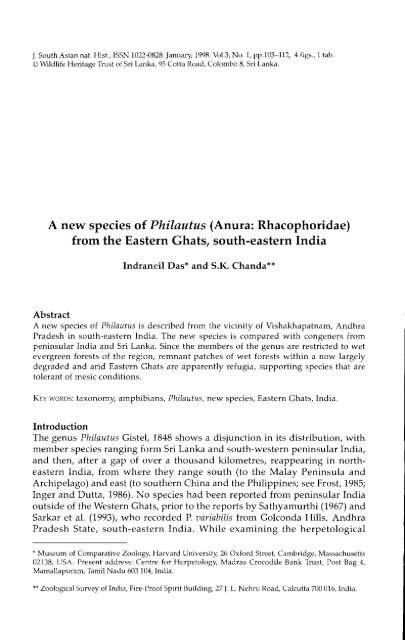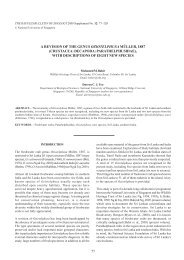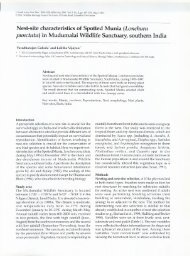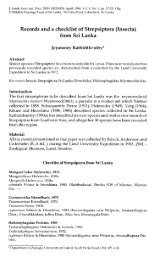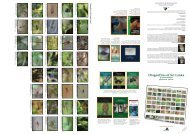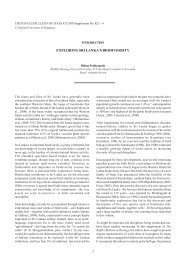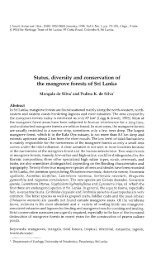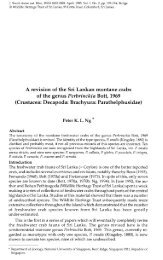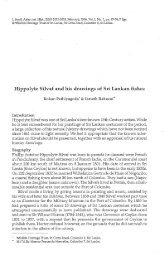(Anura: Rhacophoridae) from the Eastern Ghats, south ... - WHT
(Anura: Rhacophoridae) from the Eastern Ghats, south ... - WHT
(Anura: Rhacophoridae) from the Eastern Ghats, south ... - WHT
You also want an ePaper? Increase the reach of your titles
YUMPU automatically turns print PDFs into web optimized ePapers that Google loves.
J. South Asian nat. Hist., ISSN 1022-0828. January, 1998. Vol.3, No. 1, pp.103-112, 4 figs., 1 tab.© Wildlife Heritage Trust of Sri Lanka, 95 Cotta Road, Colombo 8, Sri Lanka.A new species of Philautus (<strong>Anura</strong>: <strong>Rhacophoridae</strong>)<strong>from</strong> <strong>the</strong> <strong>Eastern</strong> <strong>Ghats</strong>, <strong>south</strong>-eastern IndiaIndraneil Das* and S.K. Chanda**AbstractA new species of Philautus is described <strong>from</strong> <strong>the</strong> vicinity of Vishakhapatnam, AndhraPradesh in <strong>south</strong>-eastern India. The new species is compared with congeners <strong>from</strong>peninsular India and Sri Lanka. Since <strong>the</strong> members of <strong>the</strong> genus are restricted to wetevergreen forests of <strong>the</strong> region, remnant patches of wet forests within a now largelydegraded and arid <strong>Eastern</strong> <strong>Ghats</strong> are apparently refugia, supporting species that aretolerant of mesic conditions.K e y w o r d s : taxonomy, amphibians, Philautus, new species, <strong>Eastern</strong> <strong>Ghats</strong>, India.IntroductionThe genus Philautus Gistel, 1848 shows a disjunction in its distribution, withmember species ranging form Sri Lanka and <strong>south</strong>-western peninsular India,and <strong>the</strong>n, after a gap of over a thousand kilometres, reappearing in nor<strong>the</strong>asternIndia, <strong>from</strong> where <strong>the</strong>y range <strong>south</strong> (to <strong>the</strong> Malay Peninsula andArchipelago) and east (to sou<strong>the</strong>rn China and <strong>the</strong> Philippines; see Frost, 1985;Inger and Dutta, 1986). No species had been reported <strong>from</strong> peninsular Indiaoutside of <strong>the</strong> Western <strong>Ghats</strong>, prior to <strong>the</strong> reports by Sathyamurthi (1967) andSarkar et al. (1993), who recorded P. variabilis <strong>from</strong> Golconda Hills, AndhraPradesh State, <strong>south</strong>-eastern India. While examining <strong>the</strong> herpetological* Museum of Comparative Zoology, Harvard University, 26 Oxford Street, Cambridge, Massachusetts02138, USA. Present address: Centre for Herpetology, Madras Crocodile Bank Trust, Post Bag 4,Mamallapuram, Tamil Nadu 603 104, India.** Zoological Survey of India, Fire-Proof Spirit Building, 27 J. L. Nehru Road, Calcutta 700 016, India.
D a s & C h a n d acollections of <strong>the</strong> United States National Museum and <strong>the</strong> Zoological Surveyof India, eight examples of a Philautus were discovered that were collected<strong>from</strong> <strong>the</strong> <strong>Eastern</strong> <strong>Ghats</strong>, including <strong>the</strong> material referred to by Sarkar et al. (1993).Prior to <strong>the</strong>ir discovery, <strong>the</strong> <strong>south</strong>-western Indian Philautus fauna was knownto contain 22 species, <strong>the</strong> Sri Lankan fauna seven species, with three speciesthat reportedly co-occur in Sri Lanka and mainland India (Dutta, 1985; Duttaand Manamendra-Arachchi, 1996).Allocation to <strong>the</strong> genus is for presence of <strong>the</strong> following features describedas diagnostic by Liem (1970): small body size (SVL < 25 mm), lack of vomerineteeth, fingers free, toes up to half webbed, circummarginal groove present,digital disc present and trapezoidal frontoparietal of <strong>the</strong> cranium. Dubois (1981)assigned <strong>the</strong> group to <strong>the</strong> tribe Philautini, within <strong>the</strong> family Ranidae (subfamilyRhacophorinae). While <strong>the</strong>re has been no revision of <strong>the</strong> speciose fauna <strong>from</strong><strong>south</strong>-western India since Ahl (1931), Dring (1987) revised <strong>the</strong> Bornean Philautusspecies and considered loss of vomerine teeth, reduction or loss of nuptialpads and pigmented ova to be derived characters within <strong>the</strong> genus.Materials and methodsMeasurements were taken with Mitutoyo dial vernier callipers (to <strong>the</strong> nearest0.1 mm) <strong>from</strong> specimens that have been preserved in ethanol. Data onmeasurements of <strong>the</strong> paratypes should be used with caution since <strong>the</strong>se weremeasured over 120 years after collection. The following measurements weretaken: snout-vent length, SVL (<strong>from</strong> tip of snout to vent); tibia length, TBL(distance between surface of knee to surface of heel, with both tibia and tarsusflexed); trunk length, TL (distance between posterior edge of forelimb at itsinsertion to body to anterior edge of hind limb at its insertion to body); headlength, HL (distance between angle of jaws and snout-tip); head width, HW(measured at angle of jaws); head depth, HD (greatest transverse depth of head,taken beyond orbital region); eye diameter, ED (diameter of orbit); eye totympanum distance, E-T (distance between posterior most point of eyes andanterior most point of tympanum); upper eyelid width, UE (greatest width ofupper eyelid); interorbital width 10 (least distance between upper eyelids);internarial distance, IN (distance between nostrils); eye to snout-tip distance,E-S (distance between anterior-most point of eyes to tip of snout); eye to nostrildistance, E-N (distance between anterior-most point of eyes and nostrils);greatest horizontal diameter of tympanum, HTYD (measured along horizontalplane); greatest vertical diameter of typanum, VTYD (measured along verticalplane); and diameter of disk on finger III, FIIID (width of disk at tip of fingerIII). X-rays were taken with a Picker unit (Picker X-ray Corporation, Cleveland,USA), operated at 20 kV (2 milliamperes) for 30 seconds, using Kodak IndustrexM film.Institutional abbreviations follow Leviton et al. (1985). Sources ofinformation of distribution of conspecifics with which <strong>the</strong> new species hasbeen compared are Duellman (1993), and Frost (1985). Comparative materialexamined are in Appendix I, o<strong>the</strong>r nominal species, especially Rao's (1937)new species, which are, with a single exception (Philautus charius), known only<strong>from</strong> <strong>the</strong> types that are now lost (see Frost, 1985) are <strong>from</strong> <strong>the</strong> originaldescription.104 J. South Asian nat. Hist.
D a s & C h a n d aFigure 1. Holotype of Philautus terebrans (USNM 239428): (a) dorsal aspect; (b) ventralaspect. Marker = 10 mm.ratio 0.42), situated postero-ventrally orbit (Fig. 2); its greatest diameter at ahorizontal plane (HTYD/VTYD ratio 1.08). Nostrils laterally orientated andoval in shape, <strong>the</strong>ir greatest diameters vertically orientated. Vomerine teethabsent; choanae oval, separated <strong>from</strong> each o<strong>the</strong>r by a distance over 2 timeswidth; inferior aspect of snout weakly nicked; inner margin of mandible tipwith a slight w-shaped notch. Tongue large (4.8 mm in length), elongate (3.0 mm106 J. South Asian nat. Hist.
A n e w P h i l a u t u s f r o m t h e E a s t e r n G h a t sFigure 2. Head of holotypecf Philautus terebrans(USNM 239428) in lateralview. Marker = 3 mm.Figure 3. Fore and hindlimb of <strong>the</strong> holotype ofPhilautus terebrans (USNM239428), showing <strong>the</strong>subarticular tubercles andwebbing on <strong>the</strong> palm (left)and sole (right), respectively.Markers = 3 mm.in width), its dorsal surface smooth, lacking papillae; bifid, free posteriorly forover 33 percent of its length.Tips of fingers dilated into large, rounded and flattened disks, with distinctcircummarginal grooves separating dorsum of disks <strong>from</strong> ventrum; with asmooth, pale nuptial pad on dorsal surface of finger 1. The largest digital diskis on finger III, which is equal to horizontal diameter of tympanum (FIIID/HTYD ratio 1.0). Fingers unwebbed (Fig. 3.1); dorsal surface of base of finger Iwith a large nuptial pad, relative lengths of fingers: 3 > 2 > 4 > 1.Tibia long (TBL/SVL ratio 0.44); tips of toes strongly dilated into flatteneddisks, with circummarginal grooves that separate dorsum of disks <strong>from</strong>ventrum; and are as large as than those on fingers. Reduced webbing on toes:toe I with rudimentary webbing, outer side without a dermal fringe; webbingon toe II up to distal subarticular tubercle on outer and rudimentary at inneredge; on toe III, webbing is up to distal subarticular tubercle on outer edge,and distal subarticular tubercle on inner, on toe IV, between distal and basalsubarticular tubercle on both sides of two; and on toe V, to distal subarticulartubercle as a broad web, reaching disk base as a narrow sheath on inner edge(Fig. 3.2); outer edge of toe V without a dermal fringe; tarsal fold absent; asmall elongated inner metatarsal tubercle and a larger, oval outer metatarsaltubercles; relative lengths of toes: 4>5>3>2>1.Dorsum of body with uniformly scattered white-tipped pustules, withinterspaces much greater than conical pustules. Upper eyelids smooth; throat,Vol. 3, No. l. 107
D a s & C h a n d aFigure 4. Radiograph of <strong>the</strong> holotypeof Philautus terebrans (USNM239428).pectoral; abdominal region as well as undersurface of thighs coarsely granular;undersurface of forelimbs weakly tuberculate. Cloacal opening directedpostero-ventrally, sightly below upper level of thighs.Osteology. Radiograph (Fig. 4) of <strong>the</strong> holotype shows trapezoidal frontoparietals,convex anterior end of maxilla, reduced nasals, presacral region withseven vertebrae, sacral vertebra expanded distally, sphenethmoid exposurelarge; and contour of centrum of vertebrae VIII not cylindrical, considered tobe a paedomorphic condition by Liem (1970: 32).Colouration (in preservative). Unpatterned brownish-grey dorsally, fore andhind limbs banded with dark brown. A dark interorbital bar present. Tips ofdigits of fore and hind limbs cream. Throat brownish, pectoral and abdominalregions with brown variegations. An elongated, cream patch on inguinal region,anterior to which are two cream spots.EtymologyThe species name terebrans (Latin for boring), is in allusion to <strong>the</strong> lack of strikingexternal features in <strong>the</strong> new species.Natural historyNo ecological data are available on <strong>the</strong> type series, and <strong>the</strong> larval stages of <strong>the</strong>new species are unknown.ComparisonsIn <strong>the</strong> following list, <strong>the</strong> new species <strong>from</strong> Andhra Pradesh, <strong>south</strong>-eastern India,is compared with congeners <strong>from</strong> sou<strong>the</strong>rn India and Sri Lanka. Only charactersthat separate congeners <strong>from</strong> <strong>the</strong> new species have been listed.Philautus beddomii (Gun<strong>the</strong>r,1875) (distribution: <strong>south</strong>-western India),tympanum small, concealed; snout length equals orbit; metatarsal tuberclepresent; and dorsum green; P. bombayensis (Annandale, 1919) (distribution:<strong>south</strong>-western India), tongue with a median papilla; tympanum concealed;outer toes with dermal fringes; and upper eyelids with tubercles: P. chariusRao, 1937 (distribution: <strong>south</strong>-western India), head width exceeding length;tympanum in contact with orbit; upper eyelids with conical tubercles; webbingon toe IV between proximal and basal subarticular tubercles; and tongue withnumerous scattered conical papillae; P. chalazodes (Gun<strong>the</strong>r, 1875) (distribution:108 J. South Asian nat. Hist.
A n e w P h i l a u t u s f r o m t h e E a s t e r n G h a t s<strong>south</strong>-western India), presence of a median conical papilla on tongue, smallconcealed tympanum; and dorsum greenish: P. crnri Dutta, 1985 (replacementname for Philautus longicrus Rao, 1937: distribution: <strong>south</strong>-western India),presence of an outer metatarsal tubercle; and dorsum with dermal folds andtubercles; P elegans Rao, 1937 (distribution <strong>south</strong>-western India), a medianlingual papilla present; eye-nostril distance exceeds eye-snout distance; anddorsum crimson; P. eximius Shreve, 1940 (distribution: Sri Lanka), fingers weaklywebbed; webbing on toe IV on inner edge, to distal subarticular tubercle, andon outer edge, between disk and distal subarticular tubercle; inner metatarsaltubercle present; and on outer edge, between disk and distal subarticulartubercle; inner metatarsal tubercle present; area surrounding vent tuberculate;a conical lingual papilla; and presence of dermal median ridge <strong>from</strong> snout-tipto above vent; P. femoralis (Gun<strong>the</strong>r, 1864) (distribution: <strong>south</strong>-western Indiaand Sri Lanka), webbing on toe IV, on outer edge, broadly to distal subarticulartubercle, reaching disk base as a narrow sheath, and on inner edge, broadly tobasal subarticular tubercle, reaching disk base as a narrow sheath; head with adark lateral head stripe; and tongue with numerous scattered conical papillae;P. flaviventris (Boulenger, 1882) (distribution: <strong>south</strong>-western India), tongue witha median papilla); snout as long as orbit; tympanum small; and posterior edgeof thighs with rounded yellow spots.Philautus glandulosus (Jerdon, 1853) (distribution: <strong>south</strong>-western India),tympanum in contact with orbit; toe IV webbing, on outer edge, between basaland distal tubercle; on inner edge, up to basal tubercle; presence (illustrated inAhl, 1931: 131) of a dark line between posterior corner of orbit and inguinalregion; and tongue with numerous scattered conical papillae; P. hassanensisDutta, 1985 (replacement name for Philautus montanus Rao, 1937: distribution:<strong>south</strong>-western India), lingual papilla present; snout not projecting beyondmandible; larger size: SVL of holotype (sex not mentioned) of Pmontanus was37.0 mm; and a v-shaped occipital folder; P. hypomelas Gun<strong>the</strong>r, 1876, small,indistinct tympanum, an acutely orientated snout; dorsum with a thin dermalmedian ridge; and webbing on toe IV ei<strong>the</strong>r broadly up to proximal tubercle,continuing as a narrow sheath to distal tubercle or as a narrow sheath to basaltubercle; P. kottigeharensis Rao, 1937 (distribution: <strong>south</strong>-western India), acutelyorientatedsnout; eye-nostril distance equals eye-snout distance; presence of alingual papilla; and dorsum tuberculate.Philautus leucorhinus (Lichtenstein & Martens, 1856) (distribution: <strong>south</strong>westernIndia and Sri Lanka), acutely orientated snout; upper eyelids warty;webbing on toe IV, on outer edge, broadly to basal, reaching distal subarticulartubercle as a narrow sheath; on inner edge, up to basal subarticular tubercle;and tongue with numerous scattered conical papillae; P. melanensis Rao, 1937(distribution: <strong>south</strong>-western India), lingual papilla present; orbit diameterequals width of upper eyelid; and absence of an outer metatarsal tubercle; P.narainensis Rao, 1937 (distribution: <strong>south</strong>-western India), lingual papilla present;and absence of a supratympanic fold: P. nasutus (Gun<strong>the</strong>r, 1868) (distribution:Sri Lanka), presence of a dermal flap on tibio-tarsal articular region; presenceof tubercles on body dorsum; presence of an inner metatarsal tubercle andpresence of a thin dermal median ridge <strong>from</strong> snout-tip to above vent.Vol. 3, No. 1. 109
D a s & C h a n d aPhilautus noblei (Ahl, 1972) (distribution: <strong>south</strong>-western India), fingers withrudimentary webbing; lores vertical and supratympanic fold indistinct; P. parkeri(Ahl, 1972) (distribution: <strong>south</strong>-western India), larger body size: 35 mm; lorealstripe brownish; and presence of a lingual papilla; P. pulcherimus (Ahl, 1927;replacement name for Ixalus pulcher Boulenger, 1882: distribution: <strong>south</strong>westernIndia), webbed fingers; head width exceeding length; dorsum green;toes "half to two-thirds webbed", vocal sac on thoracic region, and dorsumwith a dark saddle-like mark; P. signatus (Boulenger, 1882) (distribution: <strong>south</strong>westernIndia), tongue with a conical papilla; head width exceeding length;snout as long orbit; an acutely orientated snout; tympanum small, concealed,upper labials with white spots; and dorsum with an X-shaped mark; P.swamianus Rao, 1937 (distribution: <strong>south</strong>-western India), lingual papilla present;and supratym panic fold inconspicuous P. tem poralis (Gun<strong>the</strong>r, 1864)(distribution: <strong>south</strong>-western India and Sri Lanka), tympanum in contact withorbit; snout acutely oriented; fingers weakly webbed; and webbing on innerside of toe IV fails to reach basal tubercle; P. travancoricus (Boulenger, 1891)(distribution: <strong>south</strong>-western India), snout as long as orbit; tympanumconcealed; dorsum pale, <strong>the</strong> type being described as being "cream-colour" andlarger size (SVL 31 mm); and P. variabilis (Gun<strong>the</strong>r, 1868) (distribution: <strong>south</strong>westernIndia and Sri Lanka), tympanum in contact with orbit; and webbingon toe IV between basal and distal tubercles on outer edge, and up to basaltubercle on inner edge.DiscussionThe <strong>Eastern</strong> <strong>Ghats</strong> are <strong>the</strong> wea<strong>the</strong>red remains of a fragmented and oftendiscontinuous mountain range that runs between <strong>the</strong> Khondmal Hills of OrissaState, <strong>south</strong> of <strong>the</strong> River Ganga, to its meeting point with <strong>the</strong> hill ranges of <strong>the</strong>Nilgiris, <strong>the</strong> Anaimalais and <strong>the</strong> Palnis in sou<strong>the</strong>rn Tamil Nadu State (Mani,1974). Although <strong>the</strong> reptile fauna shows endemicity both at <strong>the</strong> generic andspecific levels (Das, 1996), no endemic amphibians have hi<strong>the</strong>rto been reported.The present report of <strong>the</strong> rhacophorid, in addition to ano<strong>the</strong>r congenericrhacophorid, <strong>the</strong> description of which is now in preparation, suggests a higherdiversity of amphibians on <strong>the</strong>se hill ranges and its associated plains thanpreviously assumed. Since <strong>the</strong> holotype of <strong>the</strong> new species were collected <strong>from</strong>primary forests, <strong>the</strong> continued protection of <strong>the</strong>se remnant forest patches, andidentifying o<strong>the</strong>r relict forests that are refugia for presumably once widespreadspecies, is of great importance to <strong>the</strong> protection of <strong>the</strong> remaining biologicaldiversity of <strong>the</strong> <strong>Eastern</strong> <strong>Ghats</strong>.AcknowledgementsSupported by a Fulbright Fellowship to <strong>the</strong> first author at <strong>the</strong> Museum ofComparative Zoology, Harvard University, with additional support <strong>from</strong> <strong>the</strong>British Council Division and Smithsonian Institution. We thank Darrel Frost(American Museum of Natural History; AMNH), E. Nicholas Arnold and ColinJ. McCarthy (Natural History Museum, London; BMNH), Alan Resetar andHarold Voris (Field Museum of Natural History; FMNH); John Cadle and JoseRosado (Museum of Comparative Zoology; MCZ), George R. Zug, W. RonaldHeyer and Ronald I. Crombie (United States National Museum, Smithsonian110 J. South Asian nat. Hist.
A n e w P h i l a u t u s f r o m t h e E a s t e r n G h a t sInstitution; USNM), Kelum Manamendra-Arachchi and Rohan Pethiyagoda(Wildlife Heritage Trust of Sri Lanka; <strong>WHT</strong>), J. R. Alfred (Zoological Survey ofIndia: ZSI) and M. S. Ravichandran (Zoological Survey of India, Sou<strong>the</strong>rnRegional Collection, ZSI/SRS); for facilities and loans of specimens. Ken Tigh(USNM) helped with radiographic examination of USNM 239428. RomWhitaker provided useful comments on a draft manuscript.Literature citedAhl, E. 1931. Amphibia <strong>Anura</strong> III. Polypedatidae. Das Tierreich 55. Walter de Gruyter &Co., Berlin & Leipzig, xvi + 477 pp.Das, I. 1996. Biogeography of <strong>the</strong> reptiles of <strong>south</strong> Asia. Krieger Publishing Company,Malabar, Florida, ix + 87 pp.Dring, J. 1985. Bornean treefrogs of <strong>the</strong> genus Philautus (<strong>Rhacophoridae</strong>). Amphibia-Reptilia, 8: 19-47.Dubois, A. 1981. Liste des genres et sous-genres nominaux de Ranoidea (AmphibiensAnoures) du monde, avec identification de leurs especes-types: consequencesnomenclaturales. Monitore Zool. Ital. (n.s.), 15 (supple.): 225-284Duellman, W.E. 1993. Amphibian species of <strong>the</strong> world: Additions and corrections. Univ.Kansas Mus. nat. Hist. Sp. Publ., (21): i-iii + 1-372.Dutta, S.K. 1985. Amphibians of India and Sri Lanka. Unpublished doctoral dissertation,University of Kansas, Lawrence, Kansas. 353 pp.Dutta, S.K. & K. Manamandra- Arachchi. 1996. The amphibian fauna of Sri Lanka. WildlifeHeritage of Sri Lanka, Colombo. 230 pp.Frost, D.R. (ed.) 1985. Amphibian species of <strong>the</strong> world. A taxonomic and geographicalreference. Allen Press, Inc. and Association of Systematic Collections, Lawrence, v +732 pp.Inger, R.F. & S.K. Dutta. 1986. An overview of <strong>the</strong> amphibian fauna of India. J. Bombaynat. Hist. Soc., 83 (suppl.): 135-146Leviton, A.E., Gibbs, R.H. Jr., Heal, E. & C.E. Dawson. 1985. Standards in herpetologyand ichthyology: Part I. Standard symbolic codes for institutional resource collectionsin herpetology and ichthyology. Copeia, 1985:802-832.Liem, S.S. 1970. The morphology, systematics, and evolution of <strong>the</strong> Old World treefrogs(<strong>Rhacophoridae</strong> and Hyperoliidae). Fieldiana Zool., 57: i-vii; 1-145.Mani, M.S. 1974. The vegetation and phytogeography of <strong>the</strong> <strong>Eastern</strong> <strong>Ghats</strong>, pp. 197-203in Mani, M.S. (ed), Ecology and biogeography in India. Dr. W. Junk b.v. Publishers,The Hague.Rao, C.R.N. 1922. Notes on batrachian. J. Bombay nat. Hist. Soc., 28:439-447.Sarkar, A.K., Chandra, P.K. & S. Ray. 1993. Amphibia. In: State fauna series 5. Fauna ofAndhra Pradesh. Part I: 65-87. A.K. Ghosh (ed). Zoological Survey of India, Calcutta.Sathyamurthi, S.T. 1967. The South Indian Amphibia in <strong>the</strong> collection of <strong>the</strong> MadrasGovernment Museum. Bull Madras Gov. Mus. n.s. nat. Hist, sec., 7(2): 1-90; pi. I-XIII.Vol. 3, No. 1.Ill
D a s & C h a n d aAPPENDIXList of comparative material examinedPhilautus bombayensis: ZSI 18814, 18818, Khandala, Pune District, Maharashtra, <strong>south</strong>westernIndia; ZSI 18288, Castle Roack, North Kanara District, Karnataka State, <strong>south</strong>westernIndia.Philautus chalazodes: ZSI 17027, Anaimalai Hills, Tamil Nadu State, <strong>south</strong>-western India.Philautus charius: FMNH 218101-02, Ponmudi, Trivandrum District, Kerala State, <strong>south</strong>westernIndia; ZSI/SRS VA unregistered (field no. 18), Silver Cascade, Kodaikanal,Tamil Nadu State, <strong>south</strong>-western India.Philautus eximius: MCZ 20879-84 (syntypes of Philautus eximius Shreve, 1940),"Queenwood Estate, Dimbulla, 5000 feet, Ceylon" (=Sri Lanka).Philautus femoralis: FMNH 218114-117, Ponmudi, Trivandrum District, Kerala State, <strong>south</strong>westernIndia; MCZ 15407, Sri Lanka.Philautus flaviviridis: ZSI 10588, "South India"Philautus hypomelas: BMNH 1947.17-10; 1947.2.7.47-52 (syntypes of Ixalus hypomelasGun<strong>the</strong>r, 1876), "Ceylon" (=Sri Lanka).Philautus glandulosus: FMNH 74159-60, "South India", MCZ 79851, Ootacamund toNilambur, Tamil Nadu State, <strong>south</strong>-western India; MCZ 15408, Kudra Mukh, <strong>south</strong>westernIndia.Philautus leucorhinus: FMNH 173352,173358, Ratnapura, Sri Lanka; MCZ 8198-99, Indiaand Ceylon; MCZ 1322, "India", MCZ 3487, Nuwara Eliya, Central Province, SriLanka./ 'Philautus nasutus: MCZ 3787, Punduloya, Sri Lanka; <strong>WHT</strong>01148, Watagala, near Deniyaya,Sri Lanka; ZSI 10797, "Ceylon" (=Sri Lanka).Philautus pulcherrimus: ZSI/SRS VA 674, Varagaliar Shola, Top Slip, Anaimalai WildlifeSanctuary, Tamil Nadu, <strong>south</strong>-western India; ZSI 13565, "South India".Philautus signatus: ZSI/SRS VA 452, Silent Valley, Kerala State, <strong>south</strong>-western India; ZSI2827, "Travancore", Kerala State, <strong>south</strong>-western India.Philautus strictomerus: ZSI 10946, "Ceylon" (=Sri Lanka).Philautus temporalis: FMNH 174296-97, Kotegehar, Karnataka State, <strong>south</strong>-western India.Philautus variabilis: FMNH218133-34, Ponmudi, Trivandrum District, Kerala State, <strong>south</strong>westernIndia; FMNH 212990, Chandanthode Reserve, Trichur District, Kerala State,<strong>south</strong>-western India; MCZ 1276, India; MCZ 12895,15019, Bogawan Talawa, CentralProvince, Sri Lanka; <strong>WHT</strong> 01156, Kanneliya, Galle, Sri Lanka; ZSI/SRS VA 672,Kamaraj Sagar, Ooty, Tamil Nadu, <strong>south</strong>-western India.112 J. South Asian nat. Hist.


